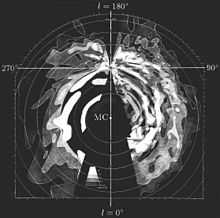Dwingeloo Radio Observatory

The Dwingeloo Radio Observatory (near Dwingeloo, m. Westerveld, in the northeastern Netherlands), is a single-dish radio telescope with a diameter of 25 m. Construction started in 1954, and the telescope was completed in 1956. At that time it was the largest radio telescope in the world. As of 2000, it was no longer in operation in an official capacity and since August 2009 is officially a Dutch industrial heritage monument. It was removed for restoration[1] in June 2012 and re-mounted[2] in November 2012.
The "C.A. Muller Radio Astronomy Station" foundation ("CAMRAS" for short) restored the telescope to working order, with the consent of ASTRON, the owner of the telescope.
Paul Boven (JIVE, CAMRAS), along with radio amateurs and amateur astronomers, use the telescope for projects, one being EME (communications). EME, also known as moonbounce, allows for people on different parts of Earth to communicate via the Moon. In this technique, radio wave signals are aimed at the Moon by one location, bounce off the Moon's surface, and are detected by an antenna at a different location on Earth.
The site of the Dwingeloo Radio Observatory also houses most of the staff of ASTRON, and a test site for LOFAR.
Two galaxies are named after this telescope: Dwingeloo 1 and Dwingeloo 2.
References
External links
-
 Media related to Radiotelescoop Dwingeloo at Wikimedia Commons
Media related to Radiotelescoop Dwingeloo at Wikimedia Commons - ASTRON
- CAMRAS
- Westerhout, Gart (December 1958). "A survey of the continuous radiation from the Galactic System at a frequency of 1390 Mc/s". Bulletin of the Astronomical Institutes of the Netherlands 14: 215. Bibcode:1958BAN....14..215W.
| |
Dutch Rijksmonument 530829 |